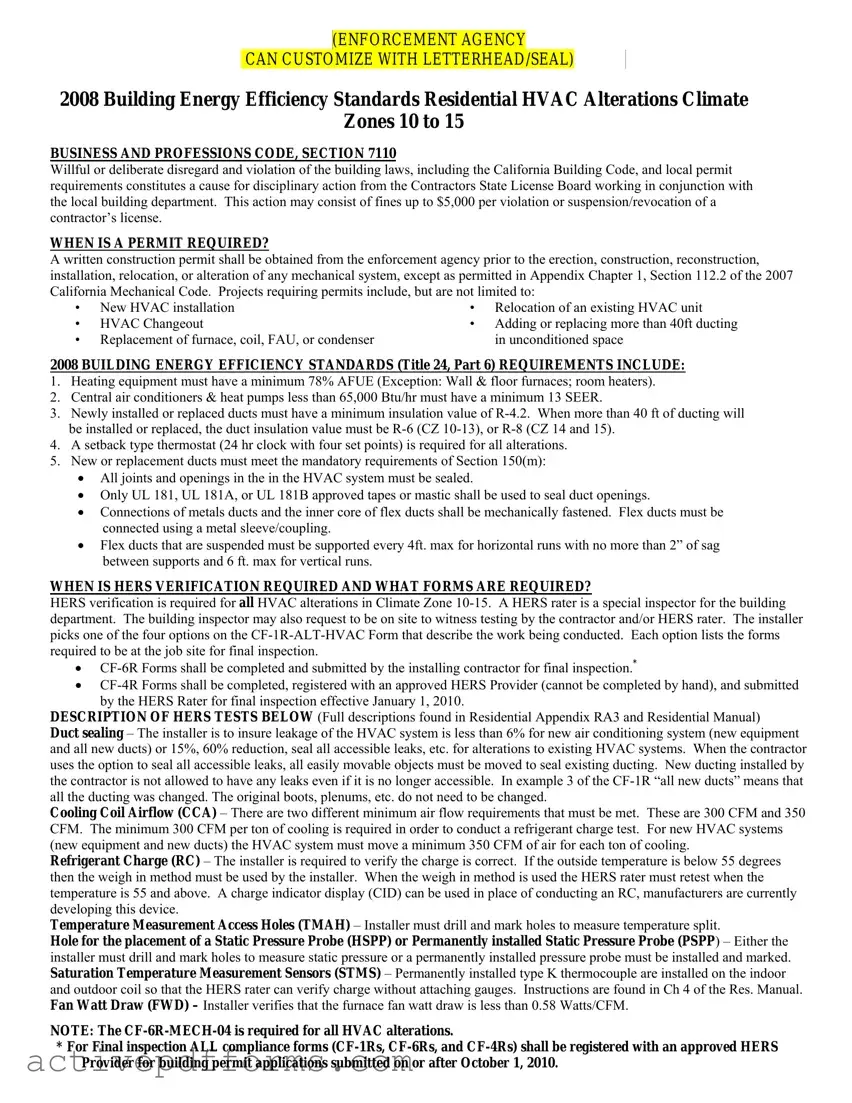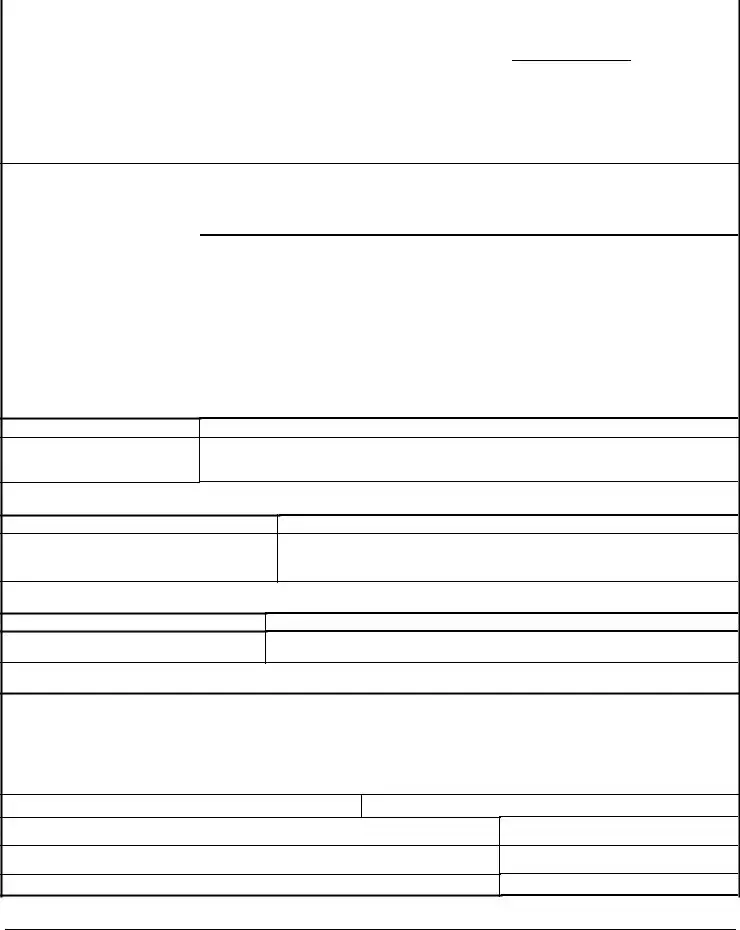(ENFORCEMENT AGENCY CAN CUSTOMIZE WITH LETTERHEAD/SEAL)
2008 Building Energy Efficiency Standards Residential HVAC Alterations Climate
Zones 10 to 15
BUSINESS AND PROFESSIONS CODE, SECTION 7110
Willful or deliberate disregard and violation of the building laws, including the California Building Code, and local permit requirements constitutes a cause for disciplinary action from the Contractors State License Board working in conjunction with the local building department. This action may consist of fines up to $5,000 per violation or suspension/revocation of a contractor’s license.
WHEN IS A PERMIT REQUIRED?
A written construction permit shall be obtained from the enforcement agency prior to the erection, construction, reconstruction, installation, relocation, or alteration of any mechanical system, except as permitted in Appendix Chapter 1, Section 112.2 of the 2007 California Mechanical Code. Projects requiring permits include, but are not limited to:
• |
New HVAC installation |
• |
Relocation of an existing HVAC unit |
• |
HVAC Changeout |
• |
Adding or replacing more than 40ft ducting |
• Replacement of furnace, coil, FAU, or condenser |
|
in unconditioned space |
2008 BUILDING ENERGY EFFICIENCY STANDARDS (Title 24, Part 6) REQUIREMENTS INCLUDE:
1.Heating equipment must have a minimum 78% AFUE (Exception: Wall & floor furnaces; room heaters).
2.Central air conditioners & heat pumps less than 65,000 Btu/hr must have a minimum 13 SEER.
3.Newly installed or replaced ducts must have a minimum insulation value of R-4.2. When more than 40 ft of ducting will be installed or replaced, the duct insulation value must be R-6 (CZ 10-13), or R-8 (CZ 14 and 15).
4.A setback type thermostat (24 hr clock with four set points) is required for all alterations.
5.New or replacement ducts must meet the mandatory requirements of Section 150(m):
•All joints and openings in the in the HVAC system must be sealed.
•Only UL 181, UL 181A, or UL 181B approved tapes or mastic shall be used to seal duct openings.
•Connections of metals ducts and the inner core of flex ducts shall be mechanically fastened. Flex ducts must be connected using a metal sleeve/coupling.
•Flex ducts that are suspended must be supported every 4ft. max for horizontal runs with no more than 2” of sag between supports and 6 ft. max for vertical runs.
WHEN IS HERS VERIFICATION REQUIRED AND WHAT FORMS ARE REQUIRED?
HERS verification is required for all HVAC alterations in Climate Zone 10-15. A HERS rater is a special inspector for the building department. The building inspector may also request to be on site to witness testing by the contractor and/or HERS rater. The installer picks one of the four options on the CF-1R-ALT-HVAC Form that describe the work being conducted. Each option lists the forms required to be at the job site for final inspection.
•CF-6R Forms shall be completed and submitted by the installing contractor for final inspection.*
•CF-4R Forms shall be completed, registered with an approved HERS Provider (cannot be completed by hand), and submitted by the HERS Rater for final inspection effective January 1, 2010.
DESCRIPTION OF HERS TESTS BELOW (Full descriptions found in Residential Appendix RA3 and Residential Manual)
Duct sealing – The installer is to insure leakage of the HVAC system is less than 6% for new air conditioning system (new equipment and all new ducts) or 15%, 60% reduction, seal all accessible leaks, etc. for alterations to existing HVAC systems. When the contractor uses the option to seal all accessible leaks, all easily movable objects must be moved to seal existing ducting. New ducting installed by the contractor is not allowed to have any leaks even if it is no longer accessible. In example 3 of the CF-1R “all new ducts” means that all the ducting was changed. The original boots, plenums, etc. do not need to be changed.
Cooling Coil Airflow (CCA) – There are two different minimum air flow requirements that must be met. These are 300 CFM and 350 CFM. The minimum 300 CFM per ton of cooling is required in order to conduct a refrigerant charge test. For new HVAC systems (new equipment and new ducts) the HVAC system must move a minimum 350 CFM of air for each ton of cooling.
Refrigerant Charge (RC) – The installer is required to verify the charge is correct. If the outside temperature is below 55 degrees then the weigh in method must be used by the installer. When the weigh in method is used the HERS rater must retest when the temperature is 55 and above. A charge indicator display (CID) can be used in place of conducting an RC, manufacturers are currently developing this device.
Temperature Measurement Access Holes (TMAH) – Installer must drill and mark holes to measure temperature split.
Hole for the placement of a Static Pressure Probe (HSPP) or Permanently installed Static Pressure Probe (PSPP) – Either the installer must drill and mark holes to measure static pressure or a permanently installed pressure probe must be installed and marked. Saturation Temperature Measurement Sensors (STMS) – Permanently installed type K thermocouple are installed on the indoor and outdoor coil so that the HERS rater can verify charge without attaching gauges. Instructions are found in Ch 4 of the Res. Manual. Fan Watt Draw (FWD) – Installer verifies that the furnace fan watt draw is less than 0.58 Watts/CFM.
NOTE: The CF-6R-MECH-04 is required for all HVAC alterations.
*For Final inspection ALL compliance forms (CF-1Rs, CF-6Rs, and CF-4Rs) shall be registered with an approved HERS Provider for building permit applications submitted on or after October 1, 2010.
Required Forms:
Simplified Prescriptive Certificate of Compliance: 2008 Residential HVAC Alterations |
CF-1R-ALT-HVAC |
Climate Zones 10 to 15 |
|
|
|
|
|
|
|
|
|
|
|
|
|
Site Address: |
|
|
Enforcement Agency: |
Date: |
|
Permit #: |
|
|
|
|
|
|
Equipment Type1 |
List Minimum Efficiency2 |
|
Conditioned Floor |
|
Duct insulation requirement |
Area |
|
Thermostat |
Packaged Unit |
|
|
Over 40 ft of ducts added or |
|
|
Setback |
Furnace |
AFUE____ |
COP______ |
|
|
replaced in unconditioned space |
Served by system |
|
(If not already |
Indoor Coil |
SEER_____ |
HSPF ____ |
|
R 6 (CZ 10-13) |
________ sf |
|
present, must be |
Condensing Unit |
EER _____ |
Resistance |
|
R 8 (CZ 14-15) |
|
|
installed) |
Other ________ |
|
|
|
|
|
|
|
|
|
|
1.Equipment Type: Choose the equipment being installed; if more than one system, use another CF-1R-ALT-HVAC for each system.
2.Minimum Equipment Efficiencies: 13 SEER, 78% AFUE, 7.7HSPF for typical residential systems.
HERS VERIFICATION SUMMARY Listed below are four HVAC alteration Options. The installer decides what work is being done and picks one of the appropriate Options. Each Option lists the HERS measures that must be conducted. A copy of the forms shall be left on site for final inspection and a copy given to the homeowner. At final, the inspector verifies that the work listed on this form was in fact the work completed by the installer. The inspector also verifies that each appropriate CF-6R and registered CF-4R forms (no hand filled CF-4Rs allowed) are filled out and signed. Beginning October 1, 2010, a registered copy of the CF-1R and CF-6R shall also be on site for final inspection.
|
1. HVAC Changeout |
Required Forms: |
|
• All HVAC Equipment replaced |
CF-6R forms: MECH-04, MECH-21-HERS and (for split systems) MECH- 25-HERS |
|
CF-4R forms: MECH- 21 and (for split systems) MECH-25 |
|
|
|
• Condenser Coil and /or |
CF-6R forms: MECH-21-HERS and (for split systems) MECH- 25-HERS |
|
• Indoor Coil and /or |
|
CF-4R forms: MECH- 21 and (for split systems) MECH-25 |
|
• Furnace |
|
|
For Split Systems: Duct leakage < 15 percent; RC, CCA ≥ 300 CFM/ton(Minimum Air Flow Requirement), TMAH
For Packaged Units: Duct leakage < 15 percent
Exempted from duct leakage testing if:
1. Duct system was documented to have been previously sealed and confirmed through HERS verification, or
2. Duct systems with less than 40 linear feet in unconditioned space, or
3. Existing duct systems are constructed, insulated or sealed with asbestos
2. New HVAC System
•Cut in or Changeout with new ducts: (all new ducting and all new equipment)
Required Forms:
CF-6R forms: MECH-04, MECH-20-HERS,and (for split systems) MECH-22-HERS, and MECH-25-HERS
CF-4R forms: MECH 20-, and (for split systems)MECH-22, and MECH 25
For Split Systems: Duct leakage < 6 percent; RC, CCA ≥ 350 CFM/ton, FWD, TMAH, STMS, and either HSPP or PSPP.
For Packaged Units: Duct leakage < 6 percent
3. New Ducts with/or without Replacement
•Includes replacing or installing all new ducting and/or outdoor condensing unit and/or indoor coil and/or furnace. No or some equipment changed.
Required Forms:
CF-6R forms: MECH-04, MECH-20-HERS,and (for split systems) MECH-25-HERS
CF-4R forms: MECH-20 and (for split systems) MECH-25
For Split Systems: Duct leakage < 6 percent, RC, CCA ≥ 300 CFM/ton, TMAH
For Packaged Units: Duct leakage < 6 percent
4. New Ducting over 40 feet
• Includes adding or replacing more than 40 CF-6R forms: MECH-04, MECH-21-HERS CF-4R forms: MECH-21 linear feet of duct in unconditioned space.
For split system or packaged units: Duct leakage < 15 percent
EXCEPTION: Existing duct systems constructed, insulated or sealed with asbestos.
Contractor (Documentation Author's /Responsible Designer's Declaration Statement)
•I certify that this Certificate of Compliance documentation is accurate and complete.
•I am eligible under Division 3 of the California Business and Professions Code to accept responsibility for the design identified on this Certificate of Compliance.
•I certify that the energy features and performance specifications for the design identified on this Certificate of Compliance conform to the requirements of Title 24, Parts 1 and 6 of the California Code of Regulations.
•The design features identified on this Certificate of Compliance are consistent with the information documented on other applicable compliance forms, worksheets, calculations, plans and specifications submitted to the enforcement agency for approval with the permit application.
Name:
Company:
Address:
City/State/Zip:
Signature:
Date:
License:
Phone:
2008 Residential Compliance Forms |
March 2010 |


